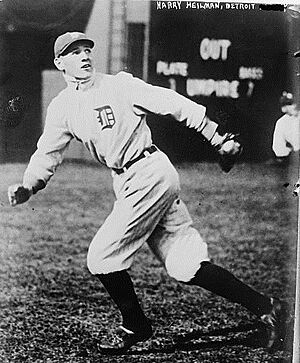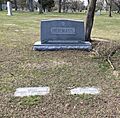Harry Heilmann facts for kids
Quick facts for kids Harry Heilmann |
|||
|---|---|---|---|

Heilmann in a 1917 Bain News Service photo
|
|||
| Right fielder / First baseman | |||
| Born: August 3, 1894 San Francisco, California, U.S. |
|||
| Died: July 9, 1951 (aged 56) Southfield, Michigan, U.S. |
|||
|
|||
| debut | |||
| May 16, 1914, for the Detroit Tigers | |||
| Last appearance | |||
| May 31, 1932, for the Cincinnati Reds | |||
| MLB statistics | |||
| Batting average | .342 | ||
| Hits | 2,660 | ||
| Home runs | 183 | ||
| Runs batted in | 1,543 | ||
| Teams | |||
|
|||
| Career highlights and awards | |||
|
|||
| Induction | 1952 | ||
| Vote | 86.8% (12th ballot) | ||
Harry Edwin Heilmann (born August 3, 1894 – died July 9, 1951) was an American baseball player and later a radio announcer. People often called him "Slug" because he wasn't very fast. He played professional baseball for 19 years, including 17 seasons in Major League Baseball (MLB). He played for the Detroit Tigers (1914, 1916–1929) and the Cincinnati Reds (1930, 1932). After his playing career, he became a popular radio announcer for the Tigers for 17 years (1934–1950).
Heilmann was an amazing hitter. He won the American League batting championship four times: in 1921, 1923, 1925, and 1927. He played in over 2,100 major league games. His career batting average was .342, which is one of the highest in baseball history. He is one of only six players in American League history to hit over .400 in a single season, which he did in 1923 with a .403 average. He was elected into the Baseball Hall of Fame in 1952, after he passed away.
Contents
Early Life
Harry Heilmann was born in San Francisco, California, in 1894. His father, Richard, ran a soap business. His mother, Mary, came from Ireland. Harry was the fourth of their children. His father died when Harry was young.
Harry's older brother, Walter, was also a talented athlete. Sadly, Walter died at age 16 in 1908. He drowned when his sailboat overturned during a storm.
Harry went to Sacred Heart Cathedral Preparatory, just like his brother. He played baseball, track, and basketball. After graduating in 1912, Harry worked as a bookkeeper.
Baseball Career
Starting in the Minor Leagues
Harry Heilmann began playing semipro baseball in 1913. A scout for the Portland Beavers noticed him. He then played for the Portland Colts, where he had a good .305 batting average.
Playing for the Detroit Tigers
Early Seasons (1914–1920)
The Detroit Tigers drafted Heilmann in 1913. He made his first MLB appearance on May 16, 1914. In 1915, the Tigers sent him to the San Francisco Seals in the Pacific Coast League. He led that league with a .364 batting average before getting sick with dizzy spells.
Heilmann returned to the Tigers in 1916. He started to show his hitting skills. That year, he became a local hero in Detroit. On July 25, 1916, he bravely dove into the Detroit River to save a woman whose car had rolled in. This act was reported across the country.
In 1917, he continued to improve his hitting. However, he was known for being a slow runner and struggled in the outfield. This is how he got his nickname "Slug." In 1918, he left the Tigers to join the United States Navy during World War I. He served on submarines.
Heilmann came back to the Tigers in 1919. He had his best season yet, hitting .320. He continued to hit well in 1920. However, he still made many errors as a first baseman.
On October 5, 1920, Harry married Mary H. Maynes, also known as Mae. They had two children, Mary Ellen and Harry Jr.
Winning His First Batting Title (1921)
In 1921, Heilmann had an amazing season. He played mostly as the Tigers' right fielder. He won his first batting title with a .394 batting average. He beat his manager and teammate, Ty Cobb, who hit .389. Harry was the first right-handed batter to win the American League batting title since 1905.
Many people wondered why Heilmann's hitting improved so much. Some thought it was because Ty Cobb became the Tigers' manager. Others believed it was due to the "live-ball era" that started in 1920. This meant outfielders played deeper, allowing more of Heilmann's hard-hit balls to land for hits.
Heilmann was known for hitting hard line drives. He also had power. In 1921, he hit 19 home runs. One of his home runs was said to have traveled an incredible 610 feet! This was much farther than most home runs at the time.
The 1921 Tigers were a great hitting team. They had the highest team batting average in American League history. But their pitching wasn't as strong, so they finished in sixth place.
Hitting Style and Speed
Heilmann was famous for hitting the ball harder than almost anyone else, except for Babe Ruth. His biggest weakness was his lack of speed. This is why he was called "Slug." Sportswriters often said he was one of the slowest great hitters ever. His slow running meant he didn't get many infield hits.
Injuries and a .400 Season (1922–1923)
In 1922, Heilmann had a contract dispute but eventually signed with the Tigers. His season ended early in August when he broke his collarbone and shoulder. He was trying to get an infield hit when he crashed into another player. Despite missing many games, he still hit a career-high 21 home runs.
In 1923, Harry worked hard to recover. He played handball to get back in shape and lose weight. This helped him have an incredible season. He won his second batting title, hitting an amazing .403! He was only the fourth American League player to hit .400 or more in a season. Only one other player has done it since 1923.
Heilmann's .403 average also meant he stopped Babe Ruth from winning the Major League Baseball Triple Crown. Ruth led the league in home runs and RBIs, but Heilmann beat him in batting average.
More Great Seasons (1924–1927)
In 1924, Heilmann's batting average dropped to .346, but he still led the league with 45 doubles. He also had his best defensive season, leading all right fielders in assists.
In 1925, he won his third batting title with a .393 average. It was a very close race that came down to the last day of the season. He got six hits in a doubleheader to win the title.
In 1926, Heilmann hit .367, which was fourth best in the league. He also had over 100 RBIs again. On August 8, 1926, the Tigers held "Harry Heilmann Day." He received a new Cadillac car in front of 40,000 fans!
Heilmann won his fourth and final batting title in 1927, hitting .398. Again, it was a very close race that he won on the last day of the season. He joked that he always played extra hard when a new contract was coming up!
Later Years with Tigers (1928–1929)
In 1928, Heilmann's average dropped to .328, but he still had good numbers for RBIs and doubles. In 1929, he played in 125 games and hit .344.
Moving to the Cincinnati Reds
In October 1929, the Tigers sold Heilmann to the Cincinnati Reds. In 1930, he played 142 games for the Reds, hitting .333. He also hit 19 home runs and had 91 RBIs.
In March 1931, Heilmann got severe arthritis in his right wrist. The pain was so bad that he missed the entire 1931 season. He tried to come back in 1932, but his wrist was still bothering him. He played in only 15 games, mostly as a pinch hitter. He played his last major league game on May 31, 1932. His wrist had lost its strength.
Radio Career
After retiring from baseball, Harry Heilmann returned to Detroit. He tried to become the Detroit City Treasurer in 1933 but lost the election. He also briefly played for a semipro baseball team.
In 1934, Heilmann started a new career as a radio broadcaster for the Detroit Tigers. He became very popular for his play-by-play announcing. He would describe the game as it happened. From 1942 to 1950, he was the only radio voice for the Tigers across Michigan.
Heilmann was known for his great storytelling and deep knowledge of baseball. He would share stories from his playing days. He also had a famous line after a great play: he would stay silent to let the crowd noise be heard, then say, "Listen ... to the voice of baseball."
In 1946, he was in a car accident and broke five ribs. But he still broadcast the Tigers games from opening day! On September 11, 1948, the Tigers held "Harry Heilmann Day" at Briggs Stadium. He received a special gold pass for all games.
Death
Harry Heilmann was sick for a long time after the 1950 baseball season. In March 1951, he collapsed at spring training and was hospitalized. He passed away on July 9, 1951, from lung cancer.
The day after he died, the 1951 Major League Baseball All-Star Game was played in Detroit. It began with a moment of silence to honor him. Harry Heilmann was buried in Holy Sepulchre Cemetery in Southfield, Michigan.
Achievements and Legacy
Harry Heilmann played in 2,147 major league games. He had a career batting average of .342. Here are some of his amazing accomplishments:
- His .342 batting average is the 12th highest in major league history. For right-handed batters, it's the third highest ever.
- He is one of only six players in American League history to hit .400 or more in a season. He did this in 1923 with a .403 average.
- He is one of only six players to win four or more American League batting titles.
- When he retired in 1932, his 542 doubles ranked sixth in baseball history. His 1,543 RBIs ranked eighth.
Before Heilmann passed away, many people, including baseball legend Ty Cobb, wanted him to be elected into the Baseball Hall of Fame quickly. He had received many votes but not quite enough. After he died, in January 1952, the Hall of Fame announced that he would be inducted. His wife represented him at the ceremony.
Harry Heilmann is still remembered as one of baseball's greatest players.
- In 1969, fans voted him as one of the top three outfielders for the all-time Detroit Tigers team.
- In 1994, fellow Hall of Famer Ted Williams called Heilmann the 17th best hitter of all time.
- In 1999, The Sporting News ranked him 54th on their list of the 100 Greatest Baseball Players.
- Also in 1999, he was chosen as one of the 100 greatest players for Major League Baseball's All-Century Team.
Images for kids
See also
 In Spanish: Harry Heilmann para niños
In Spanish: Harry Heilmann para niños
- List of Major League Baseball batting champions
- List of Major League Baseball annual doubles leaders
- List of Major League Baseball doubles records
- List of Major League Baseball career doubles leaders
- List of Major League Baseball career triples leaders
- List of Major League Baseball career hits leaders
- List of Major League Baseball career runs scored leaders
- List of Major League Baseball career runs batted in leaders
- List of Major League Baseball career total bases leaders





